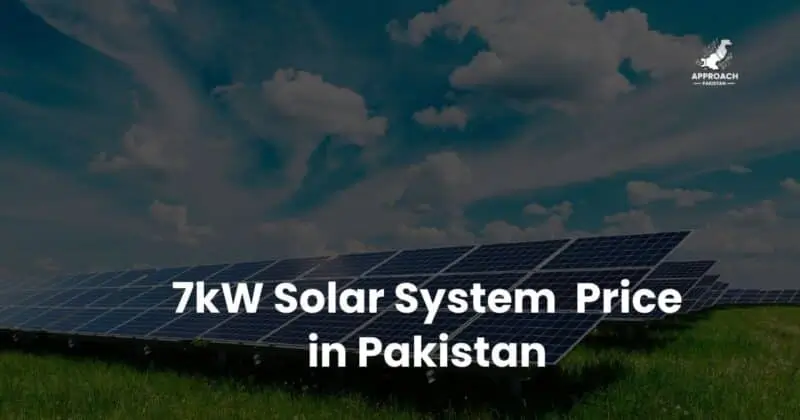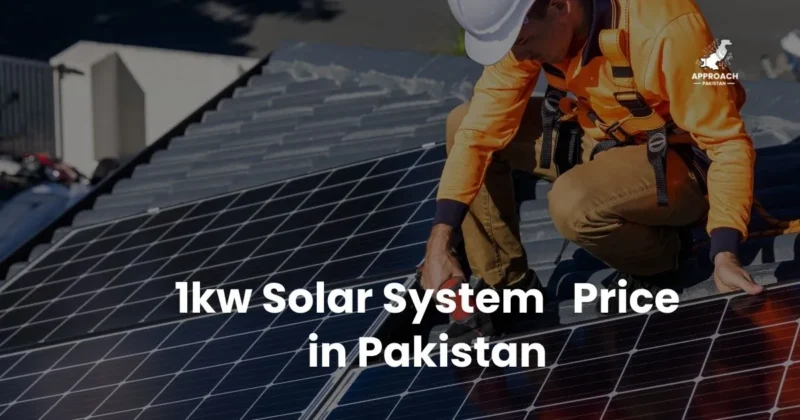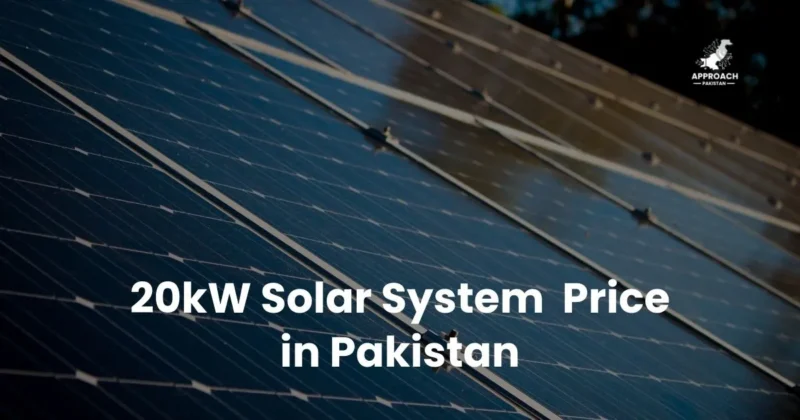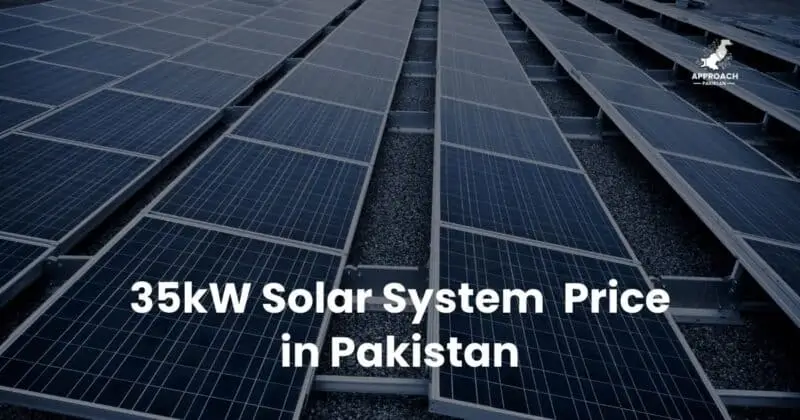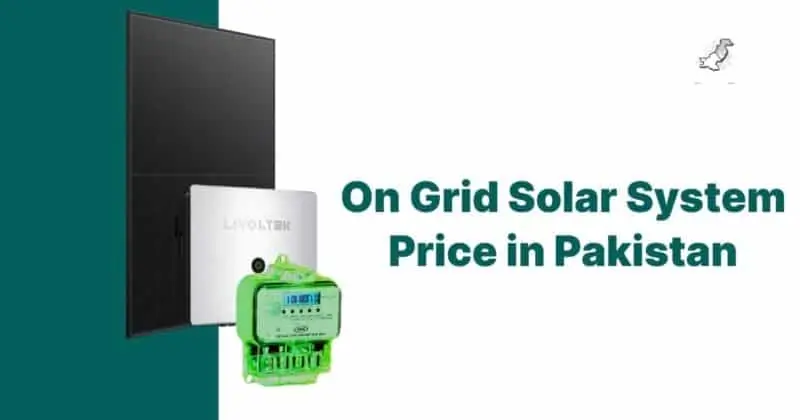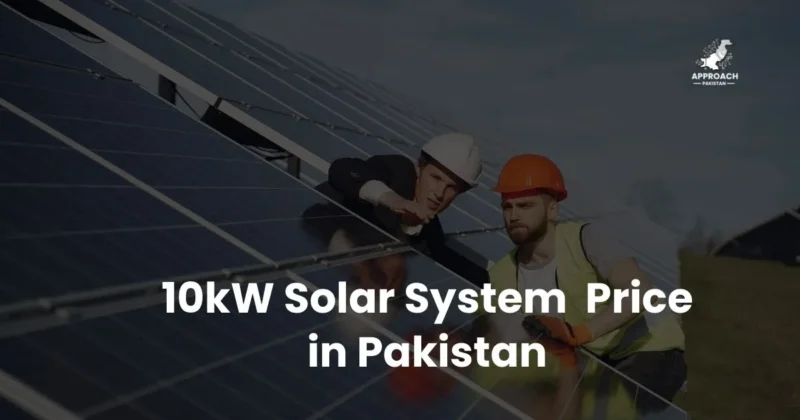Best 2kW Solar System Price in Pakistan – On-Grid/Off-Grid Costs 2025
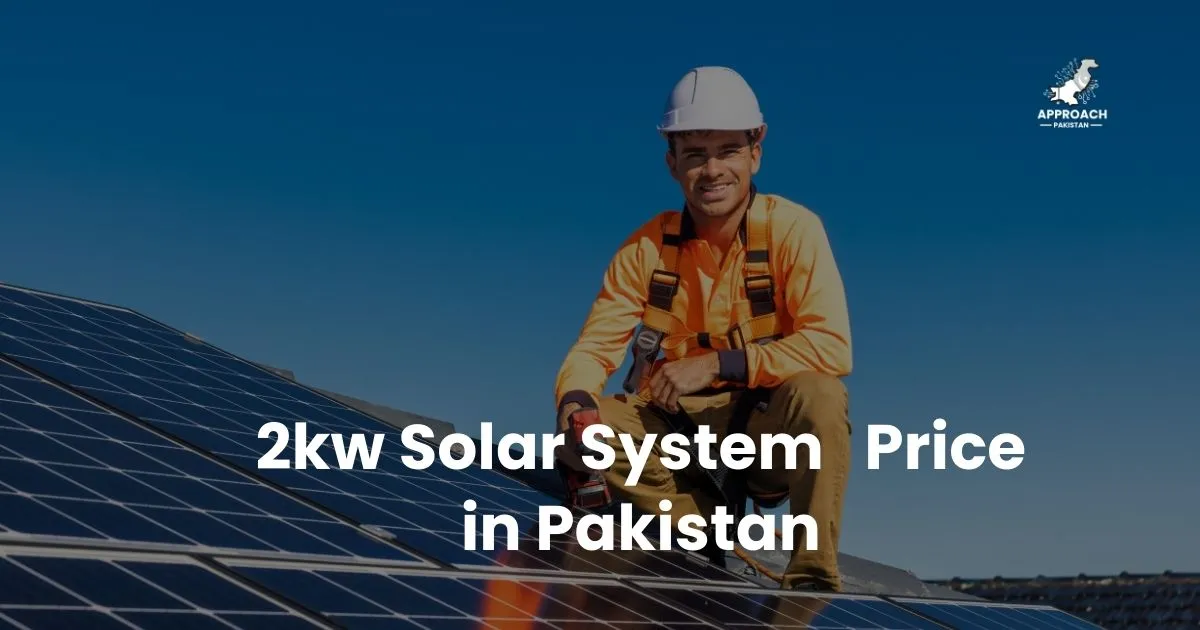
A 2kW solar system in Pakistan costs between PKR 180,000 to PKR 280,000 in 2025, depending on component quality and installation type. On-grid systems start from PKR 180,000, while off-grid systems with batteries range from PKR 220,000 to PKR 280,000.
Rising electricity bills drain your monthly budget faster than water through a sieve. Power outages leave you sweating in the dark, wondering when relief will come. You’re tired of being at the mercy of an unreliable grid system that seems to fail when you need it most.
The solution sits right above your head – the sun. Pakistan receives abundant sunlight year-round, making solar energy your ticket to freedom from crushing utility bills. A 2kW solar system can slash your electricity costs by 60-80% while providing reliable power during outages.
This guide cuts through the confusion surrounding 2kW solar system pricing. You’ll get clear, honest pricing without hidden costs. We’ll help you understand exactly what you’re paying for and how to make the smartest investment decision for your home.
Introduction to 2kW Solar Systems in Pakistan
1.1 What is a 2kW Solar System?
A 2kW solar system generates 2000 watts of electricity at peak sun conditions. It typically includes 6-8 solar panels, an inverter, mounting equipment, and electrical components. This system size perfectly suits small to medium-sized homes with moderate electricity consumption.
Think of a 2kW system as your personal power plant. It captures sunlight through photovoltaic panels and converts it into usable electricity. During peak hours, it produces enough power to run your essential appliances without drawing from the grid.
The “2kW” rating refers to maximum power output under ideal conditions. Real-world performance varies based on weather, panel angle, and shading. Most systems operate at 70-85% efficiency throughout the day.
1.2 2kW Solar System Price Table
| System Type | Price Range (PKR) | Components Included | Best For |
| Basic On-Grid | 180,000 – 200,000 | Tier 2 panels, basic inverter | Budget-conscious buyers |
| Premium On-Grid | 220,000 – 250,000 | Tier 1 panels, quality inverter | Long-term investment |
| Off-Grid Basic | 220,000 – 240,000 | Panels, inverter, lead-acid batteries | Remote locations |
| Off-Grid Premium | 260,000 – 280,000 | High-grade components, lithium batteries | Maximum reliability |
| Hybrid System | 240,000 – 300,000 | Grid-tie + battery backup | Complete energy security |
1.3 Why Choose Solar Energy in Pakistan?
Pakistan receives 2,900-3,200 hours of sunshine annually, making it ideal for solar energy generation. Solar systems provide energy independence, reduce electricity bills by 60-80%, and protect against rising utility costs while supporting environmental sustainability.
Your electricity meter spins like a roulette wheel, but the house always wins. Solar energy flips this equation in your favor. Instead of buying expensive grid electricity, you’re producing your own power for free after the initial investment.
Pakistan’s geographical location is a goldmine for solar energy. The country sits in the solar belt, receiving consistent sunlight throughout the year. Even during winter months, solar systems maintain 60-70% of their peak performance.
1.4 Current Electricity Crisis & Solar Solutions
Pakistan faces an energy deficit of 5,000-7,000 MW during peak demand periods. Solar systems offer immediate relief by reducing grid dependency while providing backup power during frequent outages that affect homes 8-12 hours daily.
Load shedding isn’t just an inconvenience – it’s a productivity killer. Businesses shut down, students can’t study, and families suffer in uncomfortable conditions. Solar systems act as your personal insurance policy against these disruptions.
The national grid struggles with aging infrastructure and fuel import costs. Every kilowatt you generate reduces pressure on the system while keeping money in your pocket. It’s a win-win situation that benefits both individual households and the country’s energy security.
2kW Solar System Price in Pakistan (2025 Updated)
2.1 Complete Cost Breakdown
The total cost of a 2kW solar system includes solar panels (40-50%), inverter (20-25%), batteries for off-grid systems (25-30%), mounting structure (8-10%), and installation charges (10-15%). Additional costs include electrical accessories, permits, and potential grid connection fees.
Let’s break down where your money goes. Solar panels eat up the biggest chunk of your budget, but they’re also the heart of your system. Quality panels last 25+ years, making this investment worthwhile.
The inverter acts as the brain, converting DC power to AC power for your home appliances. Skimping on inverter quality is like buying a luxury car with a cheap engine – it’ll cause problems down the road.
Installation costs vary by location and roof complexity. Simple installations on concrete roofs cost less than complex setups requiring structural modifications.
2.2 Component-wise Pricing Analysis
Solar panels cost PKR 22-35 per watt, inverters range from PKR 25,000-45,000, batteries (for off-grid) cost PKR 18,000-35,000 each, mounting structures cost PKR 8,000-12,000, and installation charges range from PKR 15,000-25,000 depending on complexity.
Panel prices fluctuate based on global market conditions and import duties. Tier 1 panels command premium prices but offer better performance and longer warranties. Tier 2 panels provide good value for budget-conscious buyers.
String inverters dominate the Pakistani market due to their cost-effectiveness. Power optimizers and micro-inverters cost more but offer better performance in partially shaded conditions.
Battery prices have dropped significantly over the past few years. Lithium batteries cost 2-3 times more than lead-acid but last longer and require less maintenance.
2.3 Price Comparison by Cities
| City | Basic System (PKR) | Premium System (PKR) | Installation Premium |
| Karachi | 185,000 – 205,000 | 225,000 – 255,000 | Standard rates |
| Lahore | 180,000 – 200,000 | 220,000 – 250,000 | Standard rates |
| Islamabad | 190,000 – 210,000 | 230,000 – 260,000 | 5-8% higher |
| Faisalabad | 175,000 – 195,000 | 215,000 – 245,000 | 3-5% lower |
| Peshawar | 185,000 – 205,000 | 225,000 – 255,000 | Standard rates |
| Quetta | 195,000 – 215,000 | 235,000 – 265,000 | 8-12% higher |
2.4 Budget vs Premium Options
Budget systems use Tier 2 panels and basic inverters, costing PKR 180,000-200,000 with 5-10 year warranties. Premium systems feature Tier 1 panels and advanced inverters, costing PKR 230,000-260,000 with 15-25 year warranties and better performance guarantees.
Budget doesn’t always mean cheap quality. Many Tier 2 manufacturers produce reliable panels that perform well in Pakistani conditions. The trade-off comes in warranty terms and slight efficiency differences.
Premium systems offer peace of mind through longer warranties and better customer support. They typically generate 5-10% more electricity over their lifetime, which can justify the higher upfront cost.
Consider your long-term plans when choosing between budget and premium options. If you’re planning to stay in your current home for 10+ years, premium systems often provide better value.
Types of 2kW Solar Systems
3.1 On-Grid Solar Systems
On-grid systems connect directly to the utility grid, allowing excess power to be sold back through net metering. They cost PKR 180,000-250,000 but don’t provide backup power during outages. These systems offer the fastest payback period of 3-5 years.
On-grid systems work like a two-way street. During sunny days, your system feeds excess electricity back to the grid, earning you credits. At night or during cloudy weather, you draw power from the grid using these credits.
The beauty of on-grid systems lies in their simplicity. No batteries mean lower costs and minimal maintenance. You’re essentially using the national grid as your battery storage system.
However, when the grid goes down, your solar system shuts down too. This safety feature protects utility workers but leaves you without power during outages.
3.1.1 Net Metering Benefits
Net metering allows you to sell excess solar electricity to the utility company at the same rate you buy it. In Pakistan, NEPRA regulations permit net metering for systems up to 1MW, with simple application processes and automatic meter installation.
Net metering transforms your electricity meter into a cash register. During peak sun hours, when your system produces more power than you consume, the excess flows back to the grid. Your meter literally runs backwards, building up credits.
These credits offset your evening and night-time electricity consumption. In months with high solar production, you might even receive a negative bill, meaning the utility company owes you money.
The process is surprisingly straightforward. Submit your application with required documents, get approval, install your system, and WAPDA installs a bidirectional meter. The whole process typically takes 2-4 weeks.
3.1.2 Grid-Tie Installation Process
Grid-tie installation involves system design approval, WAPDA application submission, professional installation, safety inspection, and meter replacement. The entire process takes 4-6 weeks from application to commission, with most delays occurring during utility approval stages.
Start with a professional site assessment. Your installer evaluates roof condition, shading patterns, and electrical panel capacity. This determines optimal panel placement and system configuration.
Next comes the paperwork marathon. Submit your net metering application with technical drawings, equipment specifications, and electrical single-line diagrams. WAPDA reviews and approves compliant applications within 2-3 weeks.
Installation day arrives with a bang – literally, as mounting hardware gets drilled into your roof. Professional installers complete typical 2kW installations in 6-8 hours, including electrical connections and system commissioning.
3.2 Off-Grid Solar Systems
Off-grid systems operate independently from the utility grid, using batteries to store excess energy for nighttime and cloudy day usage. They cost PKR 220,000-280,000 but provide complete energy independence and backup power during outages.
Off-grid systems are like having your own personal power company. You generate, store, and consume electricity without any connection to the national grid. This independence comes at a price – literally and figuratively.
Battery storage adds complexity and cost but delivers energy security. You’re protected from load shedding, voltage fluctuations, and rising electricity rates. Your home becomes an energy island, self-sufficient and reliable.
Sizing matters more in off-grid systems. You need enough battery capacity to cover your nighttime consumption plus 2-3 days of backup for cloudy weather. Under-sizing leads to frequent power shortages.
3.2.1 Battery Storage Solutions
Battery capacity for 2kW off-grid systems ranges from 200-400Ah, with lead-acid batteries costing PKR 18,000-25,000 each and lithium batteries costing PKR 45,000-65,000 each. Proper sizing requires 2-3 days of backup power calculation based on daily consumption.
Battery technology has come a long way, but choosing the right type still matters. Lead-acid batteries offer proven reliability at budget-friendly prices. They’re like the reliable sedan of the battery world – not flashy, but they get the job done.
Lithium batteries are the luxury SUV option. They cost more upfront but last 2-3 times longer than lead-acid. They also charge faster, discharge deeper, and require less maintenance. For many homeowners, the extra cost pays off over time.
Proper battery maintenance extends lifespan significantly. Keep terminals clean, maintain proper electrolyte levels in flooded batteries, and avoid deep discharges. A well-maintained battery bank can last 5-8 years.
3.2.2 Complete Energy Independence
Off-grid systems provide 100% energy independence, eliminating electricity bills entirely. With proper sizing, they can power essential appliances 24/7, including lights, fans, refrigerators, and TV, making them ideal for remote locations or areas with unreliable grid power.
Energy independence feels like financial freedom. No more shocking electricity bills. No more load shedding schedules to plan around. Your home operates on your terms, powered by free sunlight.
The psychological benefits match the financial ones. You’re no longer at the mercy of utility company decisions or government energy policies. Rate hikes don’t affect you. Grid failures don’t disrupt your life.
However, independence requires discipline. You need to manage your energy consumption carefully, especially during low-sun periods. Energy-efficient appliances become essential rather than optional.
3.3 Hybrid Solar Systems
Hybrid systems combine grid-tie and off-grid benefits, automatically switching between solar, battery, and grid power. They cost PKR 240,000-300,000 but provide backup power during outages while enabling net metering benefits, offering the most comprehensive energy solution.
Hybrid systems are like having the best of both worlds in your energy arsenal. They intelligently manage power flow, prioritizing solar energy first, then batteries, and finally grid power. This smart switching maximizes your savings while ensuring continuous power supply.
During normal conditions, hybrid systems operate like grid-tie systems, feeding excess power back to the grid. When outages occur, they seamlessly switch to battery backup without interrupting your power supply. You don’t even notice the transition.
The investment pays off through multiple revenue streams. You save on electricity bills, earn money through net metering, and avoid costs associated with power outages. This triple benefit justifies the higher upfront cost.
3.3.1 Best of Both Worlds
Hybrid systems offer net metering benefits during normal grid operation and uninterrupted backup power during outages. They maximize solar energy utilization by storing excess power instead of curtailing it, achieving 85-95% energy independence while maintaining grid connection benefits.
Smart energy management distinguishes hybrid systems from basic setups. Advanced inverters monitor grid conditions, battery status, and load requirements simultaneously. They make split-second decisions to optimize energy flow and maximize savings.
Battery backup in hybrid systems typically provides 4-8 hours of essential load power. This covers most outages while keeping battery costs reasonable. You’re not trying to achieve complete independence, just reliable backup for critical appliances.
The system learns your consumption patterns over time. It knows when you typically use more power and adjusts battery charging accordingly. This intelligent behavior maximizes both savings and backup availability.
3.3.2 Automatic Switching Technology
Modern hybrid inverters use automatic transfer switches that detect grid outages within 10-20 milliseconds and seamlessly switch to battery backup. Advanced models can differentiate between essential and non-essential loads, extending backup duration by powering only critical appliances during outages.
The switching happens faster than you can blink. Sensitive electronics like computers and medical equipment continue operating without interruption. It’s like having an invisible backup generator that starts instantly and runs silently.
Load prioritization adds another layer of intelligence. The system can power essential circuits (lights, fans, refrigerator) while cutting off non-essential loads (water heater, washing machine) during extended outages. This doubles or triples your backup duration.
Some advanced systems even provide mobile app monitoring. You can check your system status, battery level, and power consumption from anywhere. This remote visibility helps you make informed decisions about energy usage.
2KW Solar System Essential Components & Specifications
4.1 Solar Panels Selection Guide
2kW systems typically use 6-8 panels of 300-350W each, with monocrystalline panels offering 20-22% efficiency and polycrystalline panels providing 16-18% efficiency. Tier 1 panels from brands like Jinko, Trina, and Canadian Solar cost PKR 28-35 per watt, while Tier 2 panels cost PKR 22-28 per watt.
Panel selection sets the foundation for your entire system. Like choosing the engine for your car, this decision impacts performance for the next 25 years. Quality panels maintain 80% of their original output after two decades of service.
Efficiency ratings tell only part of the story. Temperature coefficient matters more in Pakistan’s hot climate. Panels with better temperature coefficients (-0.38%/°C or better) perform significantly better during summer months when temperatures soar above 40°C.
Brand reputation carries weight in the solar industry. Tier 1 manufacturers invest heavily in research and development, quality control, and customer support. They’re more likely to honor warranties and provide reliable performance data.
4.1.1 Tier 1 vs Tier 2 Panels
Tier 1 panels come from financially stable manufacturers with proven track records, offering 15-25 year warranties and bankability for financing. Tier 2 panels provide good value with 5-12 year warranties but may have limited long-term support, making them suitable for budget-conscious buyers who prioritize immediate savings.
The tier system isn’t just marketing fluff – it reflects real differences in manufacturing quality and business stability. Tier 1 companies undergo rigorous financial auditing and maintain consistent production standards. They’re less likely to disappear before your warranty expires.
Tier 2 manufacturers often produce excellent panels but may lack the financial resources for long-term warranty support. They compete on price, making their products attractive for immediate savings. The trade-off comes in long-term security and support.
Consider your risk tolerance when choosing between tiers. If warranty claims and long-term support matter more than upfront savings, Tier 1 panels justify their premium. For budget-focused buyers, quality Tier 2 panels offer excellent value.
4.1.2 Monocrystalline vs Polycrystalline
Monocrystalline panels offer 20-22% efficiency and better low-light performance but cost 10-15% more than polycrystalline panels which provide 16-18% efficiency. For Pakistan’s high-sun conditions, both technologies perform well, with monocrystalline panels slightly better in limited roof space situations.
The manufacturing process creates key differences between these technologies. Monocrystalline panels use single-crystal silicon, creating a uniform structure that converts sunlight more efficiently. They’re like precision-cut diamonds in the solar world.
Polycrystalline panels use multiple silicon crystals melted together, creating a slightly less efficient but more cost-effective solution. Think of them as the reliable workhorse option that gets the job done without breaking the bank.
In Pakistan’s bright sunshine, the efficiency difference becomes less critical. Both technologies generate substantial power during peak hours. The choice often comes down to available roof space and budget constraints.
2KW Solar System Installation Process & Requirements
4.2 Inverter Types & Brands
String inverters dominate 2kW installations, costing PKR 25,000-45,000 depending on brand and features. Popular brands include Inverex, Growatt, SMA, and Fronius, with PWM controllers for basic systems and MPPT controllers for premium setups offering 15-20% better performance.
The inverter serves as your system’s brain, making crucial decisions about power conversion and system protection. A quality inverter can make average panels perform exceptionally, while a poor inverter can cripple excellent panels.
String inverters connect multiple panels in series, converting DC power to AC power at a central location. They’re cost-effective and reliable but can suffer from shading issues. If one panel gets shaded, it affects the entire string’s performance.
Inverter features vary significantly across price ranges. Basic models provide simple DC-to-AC conversion, while premium units offer monitoring, anti-islanding protection, and advanced grid support functions. Choose features based on your specific needs and budget.
4.2.1 String vs Micro Inverters
String inverters cost PKR 25,000-45,000 for 2kW systems and work well for unshaded installations. Micro inverters cost PKR 8,000-12,000 per panel but optimize each panel individually, improving performance by 15-25% in partially shaded conditions and providing panel-level monitoring.
String inverters are like having one conductor for an entire orchestra. They work beautifully when all musicians (panels) perform at the same level. But if one musician falls behind, the entire performance suffers. This is the shading problem that affects string systems.
Micro inverters assign a personal conductor to each musician. Every panel operates independently, maximizing its individual performance regardless of what neighboring panels are doing. Shading one panel doesn’t affect the others.
The cost difference is substantial. Micro inverters require 6-8 units for a 2kW system, while string inverters need only one. However, the performance benefits can justify the extra cost in shaded or complex roof configurations.
4.2.2 Top Inverter Brands in Pakistan
Inverex leads the Pakistani market with competitive pricing and local support, Growatt offers excellent value with global warranty, SMA provides premium German engineering, and Fronius delivers cutting-edge features. Prices range from PKR 25,000 (basic models) to PKR 45,000 (premium features).
Local brands like Inverex understand Pakistani conditions and provide readily available spare parts and service support. They’ve adapted their products to handle voltage fluctuations and extreme temperatures common in the local grid.
International brands bring proven technology and global warranty support. Growatt has established a strong presence with competitive pricing and reliable performance. Their inverters handle Pakistani grid conditions well while offering advanced monitoring features.
German brands like SMA and Fronius represent the premium segment. They cost more but offer superior build quality, advanced features, and exceptional reliability. These inverters often outlast the panels they’re connected to.
4.3 Battery Options & Capacity
Off-grid and hybrid systems require 200-400Ah battery capacity for 2kW installations. Lead-acid deep cycle batteries cost PKR 18,000-25,000 each, AGM batteries cost PKR 22,000-30,000 each, and lithium batteries cost PKR 45,000-65,000 each, with lithium offering 2-3 times longer lifespan.
Battery sizing requires careful calculation of your nighttime and backup power needs. Under-sizing leads to frequent power shortages and shortened battery life. Over-sizing wastes money on unnecessary capacity you’ll never use.
Deep cycle batteries are engineered for repeated charge-discharge cycles, unlike car batteries designed for short bursts of high current. Using automotive batteries in solar applications leads to premature failure and void warranties.
Temperature affects battery performance significantly. Pakistani summers can reduce battery capacity by 15-20% while shortening lifespan. Proper ventilation and temperature management become critical for maximizing battery investment.
4.3.1 Lithium vs Lead-Acid
Lithium batteries offer 80-90% depth of discharge, 3,000-5,000 cycle life, and 10-15 year lifespan compared to lead-acid batteries with 50% depth of discharge, 500-1,000 cycles, and 3-5 year lifespan. Despite higher upfront costs, lithium batteries provide better lifecycle value for most applications.
Think of battery choice like buying a vehicle. Lead-acid batteries are like buying a used economy car – low upfront cost but higher maintenance and shorter lifespan. Lithium batteries are like buying a new luxury car – expensive initially but lower long-term costs.
Lithium batteries charge faster, requiring less time to reach full capacity. This matters during short sunny periods or when running a generator for backup charging. They also discharge more efficiently, delivering consistent power until nearly empty.
Maintenance requirements differ dramatically. Lead-acid batteries need regular water top-ups, terminal cleaning, and equalization charging. Lithium batteries are virtually maintenance-free, saving time and effort over their lifespan.
4.3.2 Battery Sizing Calculator
Calculate battery capacity by determining daily energy consumption (kWh), desired backup days (typically 2-3), system voltage (12V/24V/48V), and depth of discharge limits (50% for lead-acid, 80% for lithium). Formula: Required Ah = (Daily consumption × Backup days × 1000) ÷ (System voltage × DOD percentage).
Start by listing all appliances you want to power during outages. Include lights, fans, refrigerator, TV, and charging devices. Calculate daily consumption by multiplying each appliance’s wattage by hours of daily use.
Add a 20% safety margin to account for inverter inefficiencies and battery aging. Batteries don’t maintain their original capacity throughout their lifespan. Planning for degradation prevents future power shortages.
Consider seasonal variations in your calculations. Summer months typically require more power for cooling, while winter months need less. Size your battery bank for peak demand periods to ensure year-round reliability.
4.4 Mounting & Protection Equipment
Mounting structures cost PKR 8,000-12,000 for 2kW systems, with aluminum rails preferred over galvanized steel for corrosion resistance. Protection equipment includes DC/AC disconnects (PKR 2,000-3,000), surge protectors (PKR 1,500-2,500), and grounding equipment (PKR 1,000-1,500).
Mounting systems bear the responsibility of keeping your investment secure for 25+ years. They must withstand wind loads, thermal expansion, and seismic forces while maintaining proper panel alignment. Cheap mounting systems are false economies that can lead to expensive failures.
Aluminum mounting offers superior corrosion resistance compared to galvanized steel, especially in coastal areas with salt air. The price premium pays off through longer lifespan and better appearance retention.
Safety equipment protects both your system and your family. DC and AC disconnects allow safe system shutdown during maintenance. Surge protectors guard against lightning damage and grid voltage spikes. Proper grounding prevents electrical shock hazards.
2KW Solar Power Generation & Consumption
5.1 Daily/Monthly/Yearly Output
A 2kW solar system in Pakistan generates 8-12 kWh daily, 250-350 kWh monthly, and 3,000-4,200 kWh annually depending on location, season, and system orientation. Peak performance occurs from March to October, with 20-30% reduction during winter months due to shorter days and lower sun angles.
Your solar system performs like a dedicated employee – showing up every day, working hardest during peak hours, and taking breaks when clouds roll in. Understanding this pattern helps you optimize energy usage and set realistic expectations.
Location matters significantly within Pakistan. Balochistan receives the highest solar irradiance, followed by Punjab and Sindh. Northern areas experience more seasonal variation due to latitude differences. Even within cities, microclimates can affect performance by 10-15%.
System orientation and tilt angle impact output substantially. South-facing panels at 30-degree tilt perform optimally in Pakistani conditions. East or west-facing installations lose 15-20% production, while flat installations lose 10-15% compared to optimal tilt.
5.2 Appliances You Can Run
A 2kW solar system can simultaneously power 4-6 LED lights (40W), 3-4 ceiling fans (75W each), one refrigerator (150W), one LED TV (100W), mobile phone chargers (20W), and a laptop (65W). Total simultaneous load should not exceed 1,600W to allow for inverter safety margins.
Think of your solar system like a water tank with a specific flow rate. You can draw water (electricity) continuously at a moderate rate, or quickly for short periods, but you can’t exceed the maximum flow rate without running into problems.
Energy-efficient appliances multiply your system’s effectiveness. LED lights use 80% less power than incandescent bulbs. Inverter ACs use 40% less power than conventional models. These efficiency gains effectively increase your system’s capacity.
Load management becomes crucial during peak usage periods. Running multiple high-power appliances simultaneously can overload your inverter. Stagger usage of heavy loads like water pumps, washing machines, and electric kettles.
5.3 Load Management Tips
Optimize solar system performance by running high-power appliances during peak sun hours (10 AM – 3 PM), using timers for water heaters and pumps, prioritizing energy-efficient appliances, and avoiding simultaneous operation of multiple heavy loads. Smart load management can increase system effectiveness by 30-40%.
Timing is everything in solar energy management. Run your washing machine, dishwasher, and water heater during midday when solar production peaks. This maximizes direct solar consumption and reduces battery drain or grid dependency.
Sequential loading prevents inverter overload. Instead of starting multiple appliances simultaneously, stagger their operation by 5-10 minutes. This allows the inverter to handle each load’s startup surge individually.
Programmable timers become your best friends in solar applications. Set water heaters to operate during peak sun hours. Program pool pumps to run when solar production is highest. These simple devices automate optimal energy usage.
5.4 Seasonal Performance Variations
Solar output varies 40-50% between summer and winter months in Pakistan. Peak production occurs from April to September (100-110% of rated capacity), while winter months (November to February) see 60-70% of peak performance due to shorter days, lower sun angles, and increased cloud cover.
Seasonal planning prevents disappointment and system sizing errors. Design your system for worst-case winter performance, not peak summer output. This ensures year-round energy security without over-reliance on backup power.
Dust accumulation affects performance more during dry months. Regular cleaning becomes critical from March to June when dust storms are common. Clean panels can produce 15-20% more power than dirty ones during these periods.
Monsoon seasons bring both challenges and benefits. Increased cloud cover reduces solar production, but regular rainfall naturally cleans panels. Plan for reduced output during July-August monsoon period.
2KW Financial Analysis & ROI
6.1 Payback Period Calculation
2kW solar systems in Pakistan typically pay for themselves in 3-5 years for on-grid installations and 4-6 years for off-grid systems. With electricity rates at PKR 20-35 per unit and solar systems generating 3,000-4,200 kWh annually, annual savings range from PKR 60,000-147,000 depending on system type and usage patterns.
Payback calculations require honest assessment of your electricity consumption and rates. Don’t base calculations on your lowest monthly bill – use your annual average for realistic projections. Include all applicable taxes and surcharges in your rate calculations.
On-grid systems with net metering typically achieve faster payback due to selling excess power back to the grid. Off-grid systems take longer to pay back but provide greater value through backup power and grid independence benefits.
Rising electricity rates accelerate payback periods. Pakistan’s electricity rates have increased 8-12% annually over the past decade. Solar systems provide protection against future rate increases, making the investment more attractive over time.
6.2 Monthly Savings Breakdown
Monthly electricity bill savings range from PKR 5,000-12,000 for 2kW systems depending on consumption patterns and electricity rates. On-grid systems with net metering can achieve 70-90% bill reduction, while off-grid systems eliminate electricity bills entirely but require battery replacement costs every 5-8 years.
Peak-hour usage patterns significantly impact savings potential. If you consume most electricity during evening hours when solar production is low,
your savings will be lower than someone who uses power during daylight hours. Time-of-use billing makes solar even more attractive since peak rates often coincide with peak solar production.
Net metering amplifies savings through excess power sales. During low-consumption months, you might actually receive negative bills from the utility company. These credits roll forward, offsetting higher consumption months.
Battery replacement costs affect off-grid system economics. Budget PKR 40,000-80,000 every 5-8 years for battery replacement, depending on technology chosen. Include these costs in long-term financial projections for accurate comparison.
6.3 Government Incentives & Policies
Pakistan offers net metering regulations allowing up to 1MW residential installations, exempts solar equipment from customs duties and sales tax, and provides subsidized financing through various banks. Provincial governments offer additional incentives, with Punjab providing 20% subsidies for residential solar installations.
NEPRA’s net metering regulations simplify the interconnection process and guarantee fair compensation for excess power generation. The one-to-one rate structure means you sell power at the same rate you buy it, maximizing economic benefits.
Import duty exemptions reduce system costs by 15-20% compared to countries without such policies. This government support makes solar more affordable for Pakistani consumers while encouraging local market development.
Banking partnerships provide financing options at subsidized rates. Several banks offer solar loans at 6-12% interest rates with flexible repayment terms. These programs make solar accessible to middle-class families who can’t afford upfront payments.
6.4 Financing Options Available
Solar financing options include bank loans at 8-15% interest rates, equipment financing through installers, lease-to-own programs, and government-backed subsidized loans. Many banks offer collateral-free loans up to PKR 500,000 for solar installations with 3-7 year repayment terms.
Equipment financing through installers often provides the easiest approval process. Many companies have partnerships with financial institutions, streamlining paperwork and approval procedures. Interest rates may be slightly higher but convenience often justifies the premium.
Bank loans typically offer lower interest rates for customers with good credit history. Shop around among different banks as rates and terms vary significantly. Some banks specialize in solar financing and offer more competitive packages.
Lease-to-own programs require minimal upfront investment but result in higher total costs. They’re suitable for customers who want immediate solar benefits without large initial payments. Read contracts carefully to understand total cost implications.
2KW Solar Comparison with Other System Sizes
9.1 1kW vs 2kW vs 3kW Systems
1kW systems cost PKR 90,000-140,000 and suit small apartments or minimal usage households. 2kW systems cost PKR 180,000-280,000 for average homes with moderate consumption. 3kW systems cost PKR 270,000-420,000 for larger homes or higher consumption patterns. Cost per watt decreases with larger systems.
System sizing affects economics significantly. Larger systems benefit from economies of scale in both equipment costs and installation labor. The fixed costs of permits, design, and basic installation get spread across more capacity.
1kW systems work for energy-conscious households with minimal consumption. They typically cover lighting, fans, and small appliances but can’t handle high-power devices like water heaters or washing machines simultaneously.
3kW systems suit larger families or homes with higher consumption. They can handle multiple appliances simultaneously and provide better backup power capability for off-grid configurations. The larger capacity justifies higher investment for appropriate applications.
9.2 Upgrading Your System
Solar systems are modular and expandable, allowing future capacity additions when needs grow. Plan initial installations with expansion in mind by choosing appropriately sized inverters and electrical panels. Adding panels costs less than complete system replacement when expansion becomes necessary.
Start with adequate infrastructure to support future expansion. Install larger inverters and electrical panels initially, even if using only partial capacity. This forward planning reduces future upgrade costs significantly.
Panel additions require matching or compatible technologies. Mixing different panel types can reduce system performance due to mismatched electrical characteristics. Plan expansions using similar panels when possible.
Battery bank expansions follow similar principles. Design initial banks for easy expansion and use matched battery types. Mixing old and new batteries reduces overall bank performance and lifespan.
9.3 Scalability Options
Modular design allows incremental capacity additions as budgets and needs grow. Start with basic grid-tie systems and add battery backup later. Begin with smaller capacity and expand systematically. Proper planning enables seamless integration of additional components without system redesign.
Phased implementation spreads costs over time while providing immediate benefits. Start with basic on-grid installation to begin saving money immediately. Add battery backup when budget allows for enhanced energy security.
Technology improvements over time can benefit phased approaches. Later additions might use more efficient panels or batteries at lower costs. However, compatibility considerations may limit technology mixing benefits.
Electrical design affects expansion possibilities significantly. Plan electrical layouts with future additions in mind. Install adequate conduit capacity and panel space for future components during initial construction.

